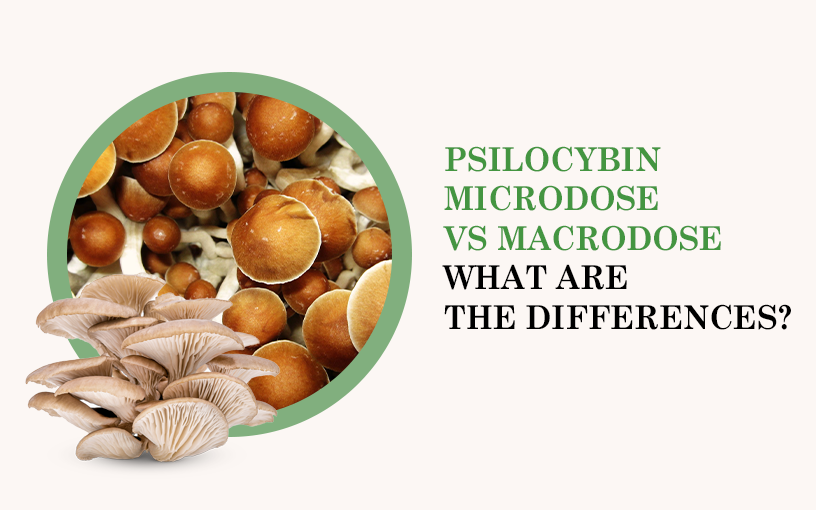Are you captivated by the increasing popularity of psilocybin, yet find yourself a bit puzzled about the difference between microdosing and macrodosing?
After diving into a wealth of research, including intriguing statistics showing over 80% users reported mental health improvements from psilocybin use, we’re primed to arm you with all the insights you need.
Welcome to your comprehensive guide on Psilocybin Microdose Vs Macrodose – consider this your roadmap for navigating through this enchanting field. Ready to embark on an enlightening voyage into the mystifying realm of shrooms?.
Key Takeaways
- Microdosing involves taking a small dose of psilocybin for potential therapeutic and cognitive benefits, while macrodosing is a larger dose that induces intense psychedelic experiences.
- The typical microdose of psilocybin is 0.1 to 0.5 grams of dried mushrooms or 5 to 20 micrograms of synthetic psilocybin, while the amount for a macrodose ranges from 2 to 5 grams.
- Microdosing can enhance everyday life without causing intense psychedelic experiences, improving mood, cognition, and problem-solving skills. Macrodosing is often used for self-exploration, spiritual experiences, or as part of therapeutic sessions.
- Benefits of microdosing include increased focus and creativity, reduced anxiety and depression symptoms; risks include psychological discomfort and tolerance build-up. Benefits of macrodosing include profound changes in perspective and treatment assistance for certain mental health conditions; risks involve severe psychological distress and dangerous behavior during use.
Understanding Microdosing and Macrodosing
Microdosing involves taking a sub-perceptual amount of psilocybin, typically ranging from 0.1 to 0.3 grams, which is significantly lower than the dose needed for a full psychedelic experience.
Definitions and dosing amounts
Psilocybin is a naturally occurring psychedelic found in certain species of mushrooms. It can be consumed in different doses, commonly referred to as microdoses and macrodoses. Below, we’ve outlined the dosages and their definitions.
Dose Type: Microdose
- Definition: A microdose is a very small dose primarily used not for its psychedelic effects, but for its potential therapeutic and cognitive benefits. While it usually doesn’t cause noticeable perceptual changes, it can subtly influence mood, cognition, and perception.
- Amount: Typically, a microdose of psilocybin ranges from 0.1 to 0.5 grams of dried mushrooms or 5 to 20 micrograms of synthetic psilocybin.
Dose Type: Macrodose
- Definition: A macrodose is a substantial dose known to induce a full psychedelic experience, which can encompass perceptual alterations, shifts in thought processes, and in certain cases, spiritual experiences.
- Amount: The quantity for a macrodose can vary based on individual tolerance and the intensity sought after. It usually falls between 2 to 5 grams of dried mushrooms.
The dosing amounts for both microdosing and macrodosing vary widely depending on various factors, such as the individual’s body weight, tolerance, and the type of mushroom or synthetic psilocybin being used.
As such, these amounts should not be considered as absolute, but merely a general guideline. Always remember to consult with a healthcare professional before consuming psilocybin in any form.
The Effects of Microdosing and Macrodosing
Microdosing and macrodosing have both similar and distinct effects on the mind and body. Let’s explore how these two dosing methods influence our perception, cognition, and overall well-being.
Read to discover the differences between microdosing and macrodosing with psilocybin?
Similarities and differences in effects
Taking a look at microdosing versus macrodosing, we will notice distinct differences and similarities in their effects.
Similarities
- Both microdosing and macrodosing can enhance creativity, focus, and mood.
- Both can foster a sense of connection to oneself and others.
- Both offer avenues for personal growth and self-discovery.
Differences
- Microdosing: Typically results in subtle enhancements suitable for day-to-day life without triggering profound psychedelic experiences. Benefits can include improved problem-solving abilities, emotional stability, and overall well-being.
- Macrodosing: Often induces intense psychedelic journeys that might encompass visual or auditory hallucinations. Primarily used for deeper self-reflection, spiritual insights, or within therapeutic contexts.
Pros and Cons of Microdosing and Macrodosing
Microdosing offers the potential for increased focus, creativity, and mental clarity, while macrodosing may provide transformative psychedelic experiences that can lead to personal growth and insight.
However, microdosing is a more subtle approach with fewer risks and side effects, whereas macrodosing carries a higher risk of experiencing intense emotions or challenging trips. It’s important to weigh the benefits and risks carefully when deciding between microdosing and macrodosing.
Microdosing vs. Macrodosing: Benefits and Risks
Benefits and risks associated with both microdosing and macrodosing are numerous and can depend on individual factors. Here is a table highlighting some of the key benefits and risks associated with both methods:
Benefits of Microdosing:
- May enhance focus and creativity.
- Potential reduction in symptoms of anxiety and depression.
- Possible enhancement of emotional balance.
- Less likely to induce major physiological changes.
Benefits of Macrodosing:
- Can bring about profound shifts in perspective.
- Might assist in addressing certain mental health issues.
- Offers opportunities for deep introspection and personal insight.
- Potential to facilitate spiritual or mystical experiences.
Risks of Microdosing:
- Potential for psychological discomfort.
- Might cause mild physiological alterations.
- Risk of unplanned tolerance accumulation.
- Limited research on long-term effects.
Risks of Macrodosing:
- Potential for psychological distress.
- Possibility of significant physiological changes.
- May lead to risky behavior during use.
- Risk of exacerbating pre-existing mental health conditions.
It’s crucial to remember that everyone’s experience with psilocybin, at any dose, can vary. The effects can depend on factors like mental health, overall health, and personal tolerance. Always consult with a healthcare professional before starting any new treatment regimen.
Conclusion: Deciding Between Microdosing and Macrodosing
In conclusion, when deciding between microdosing and macrodosing, it is important to consider various factors such as personal goals, desired effects, and individual tolerance levels.
Seeking professional guidance can also be helpful in determining the best approach for an individual’s specific needs.
Factors to consider
To make an informed decision between microdosing and macrodosing, there are several factors you should consider. These include:
- Desired Outcome: Determine what you hope to achieve with psychedelic use. Are you looking for subtle enhancements in creativity and focus (microdosing), or a more intense, transformative experience (macrodosing)?
- Personal Tolerance: Consider your past experiences with psychedelics and how different dosages have affected you. Some individuals may be more sensitive to the effects of psilocybin, while others may require higher doses to achieve their desired results.
- Safety Precautions: Understand that both microdosing and macrodosing come with potential risks, such as psychological distress or triggering underlying mental health conditions. Assess your mental state and any relevant medical history before embarking on either approach.
- Time Commitment: Reflect on the time available to devote to psychedelic experiences. Microdosing typically requires regular, consistent doses over an extended period (often weeks or months), while macrodoses necessitate longer periods of uninterrupted time for optimal integration.
- Setting: Consider the environment in which you plan to take psychedelics. Both microdosing and macrodosing benefit from a safe, comfortable space free from distractions or potential stressors. Ensure your surroundings support your intended experience.
- Legal Implications: Understand the legal status of psilocybin in your jurisdiction before making a decision about dosage strategies.
Seeking professional guidance
If you’re unsure about whether microdosing or macrodosing is right for you, it’s wise to seek professional guidance. A qualified healthcare provider or therapist with experience in psychedelic therapy can help assess your individual needs and goals.
They can provide personalized advice based on factors like your mental health history, current medications, and desired outcomes. Professional guidance ensures that you make an informed decision and approach the use of psilocybin safely and responsibly.
Remember to consult a trusted expert before starting any new treatment or regimen involving psilocybin.
FAQs
1. What are psilocybin microdose and macrodose?
Psilocybin microdose involves taking small amounts of magic mushroom capsules, while a macrodose is when one consumes larger quantities of shroom chocolate bars or other forms.
2. Where can I buy psilocybin capsules?
You can purchase both the microdose magic mushroom capsules and the larger dose varieties through trusted online platforms like Amazing Shrooms.
3. How does psilocybin in a chocolate differ from that in a capsule?
Magic Mushroom Chocolate or Shroom Chocolate Bar has psilocybin mixed with cocoa for an enjoyable experience, while Psilocybin Capsules contain pure ground magic mushrooms intended mainly for controlled dosing.
4. Can I buy shrooms online safely?
Yes, portals like Amazing Shrooms provide safe online transactions when you want to buy either magic mushroom chocolates or capsulated doses.





